NISI V7 filter holder review
Last update: 04/19/2024
Our blog continues to grow thanks to you, our readers. This post may contain affiliate links, which means we can earn a small commission if you make a purchase through them, at no extra cost to you. This helps us to continue to bring you more and support our work!
If you’ve been following us on our travel and photography blog for a while now, you’ll know that I (Sylvain) am passionate about camera lens filters. It’s something I’ve always loved and, as I often say, I prefer to spend time shooting behind my camera, rather than on a computer doing post-processing (even if I do understand the value of it).Having previously reviewed ND or GND filters from other brands, I now have the opportunity to test the new NISI V7 filter holder (100mm system).
If you still don’t know everything about filters, their use, advantages and disadvantages, I invite you to check our comprehensive article on camera lens filters. It details everything you need to know about the main camera lens filters: polarizing filters (CPL), neutral density filters (ND) and Graduated Neutral Density (GND) filters, i.e., filters with a neutral gradient.
In this article, I won’t have the opportunity to tell you about all the filters that NISI, a Chinese brand, produces, but I will give you at the end of the article my opinion on the “True Color” circular polarizing filter (CPL) included in the pack I got. As usual when entering a partnership, I mention it right from the start. The goal is to give you my most honest opinion on this brand-new filter holder and I am entirely free to write exactly what I think about the product in terms of both opinion and conclusion.
I also feel it is necessary to point out that this is the first time I am reviewing a product from NISI though I had heard mostly good things about them, especially during my research for the article on special filter holders for wide-angle lenses. Admittedly, this is not the brand’s first attempt, and this new V7 filter holder is the proud successor of the V6 filter holder. So, I am more than happy to finally get my hands on both a filter holder and a polarizing filter from them.
NISI V7 filter holder review
As usual, I will first present the gear sent, then the unwrapping and installation and, finally, its use in the field. At the end of the article, I will also showcase the True Color polarizing filter through examples “with/without” and a chat about its quality.
Camera gear sent
I received the complete package named “V7 Filter Holder with True Color CPL Filter”. At the moment and to my knowledge, this is NISI’s only package for this V7 filter holder.
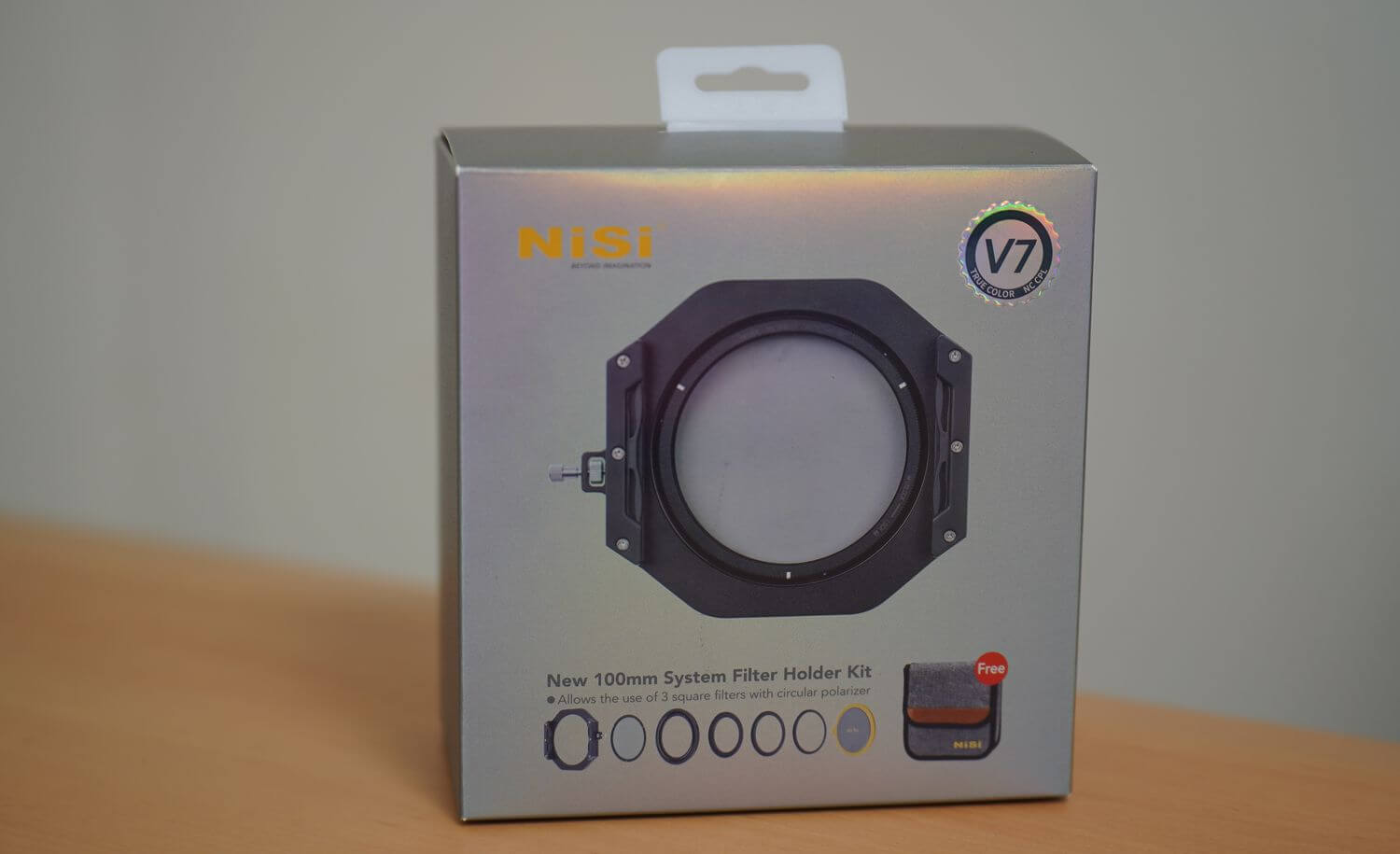
NISI V7 filter holder
Content Overview
Having crossed the Atlantic Ocean, this anxiously awaited package finally arrives, and it is well wrapped. Unwrapping it reveals the complete package. The package is relatively simple and made of shiny grey cardboard. Writing on the box lts you know that it is indeed the V7 system with the True Color PLC filter. The content is also indicated. I was perhaps expecting a little more of a “professional” packaging compared to what I had seen or tested elsewhere, but the that’s not the most important anyway. The following items are included:
- A filter case,
- The new NISI V7 100 mm filter holder system combined with an 82mm main ring on which the polarizing filter (86mm CPL) is to be mounted,
- A protective cap (compatible only with the V7’s 82mm ring),
- Three 62/72/77mm step-up rings,
- An assembly manual (multilingual).
A minor point though: the package does not come with a screwdriver system to unscrew the filter holder slides/slots. This is not a problem for me, as I already have several such accessories that came with other reviewed filter holders, but if this is the first time you purchase one, beware.
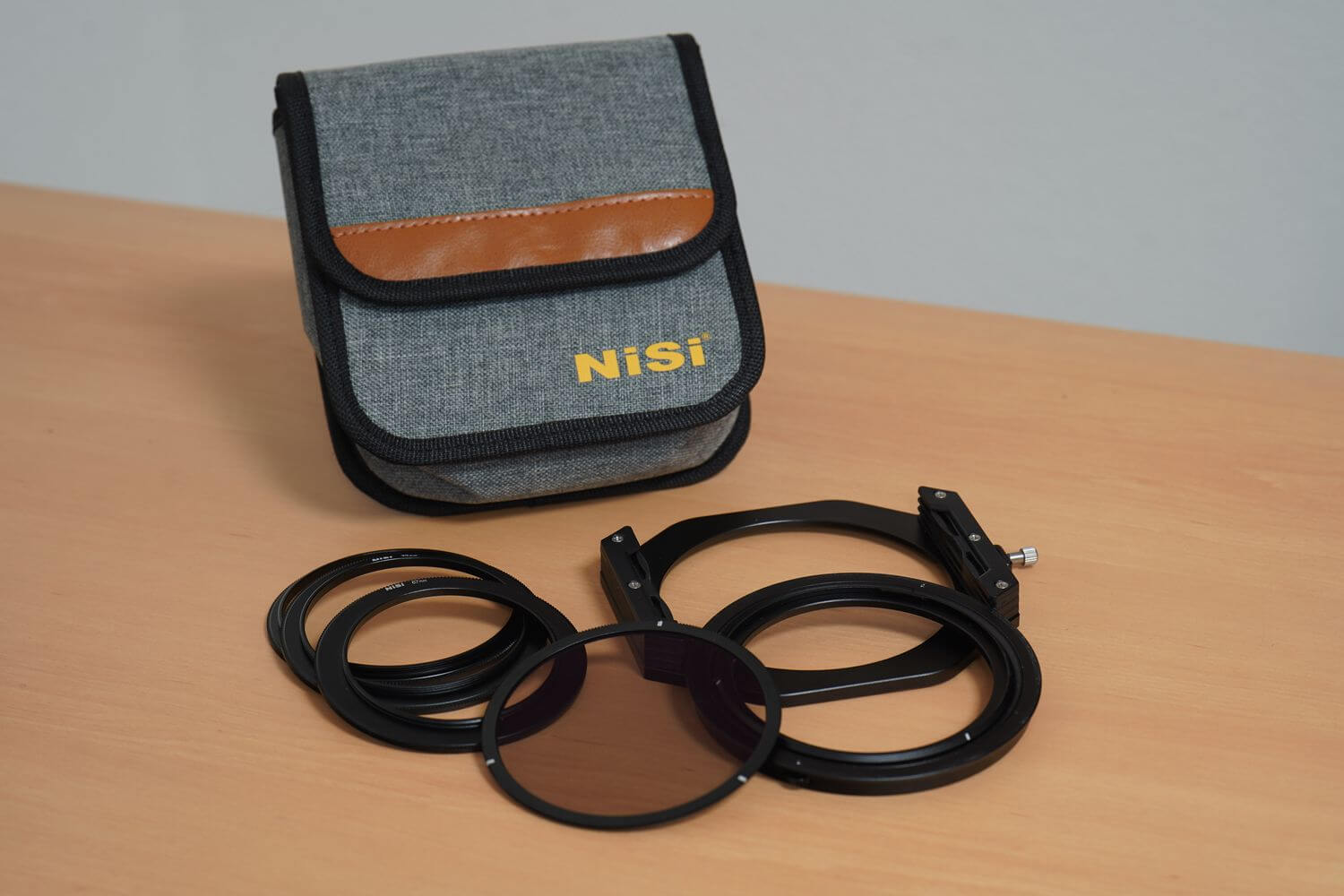
The lens case
The grey lens case appears to be of very good quality, particularly thanks to its large Velcro strap allowing it to be properly closed. The whole thing is very light, seems very sturdy and, conveniently, has a Velcro system on the back to attach it to a tripod, for example during a shooting session. The case is divided into two separate compartments to hold the filter holder, the associated 82mm ring and the mounted CPL (in the larger compartment) as well as the adapter rings (in the smaller compartment). While there’s objectively nothing to complain about, it’s still a matter of taste and as far as I am concerned, the whole thing is too bulky to be carried around all the time. I would only take the filter holder system, which I can simply store in one of my camera bag’s pockets, and keep the adapter rings somewhere else. Having said that, as far as quality is concerned, there is nothing to say, it looks very good.


NISI V7 filter holder and 82mm ring
When I first saw the filter holder, the whole thing looked extremely solid. Compared to other filter holders I have recently reviewed, the NISI V7 filter is much heavier, sturdier and conveys a feeling of robustness. This is a great thing, in my opinion. According to specifications, it is made from aircraft-grade aluminum. The filter holder is matte black with no unwanted reflections. It comes with a snap-on and slide system (three are originally fitted) on both sides of the filter holder. Three screws are used to attach the rails to the filter holder. I immediately tried inserting a GND filter I had (from another brand), just to see. Frankly, I was impressed with how well the sliding system is made. You can feel that the filters hold perfectly in place and are unlikely to fall out. With other tested models, I had always been moderately satisfied with the holding system which seemed a bit more on the “low-end” and did not tighten the filter enough for my own taste. From experience, I would say that these rails are neither too hard nor too soft, another very positive point.
On one side of the filter holder, there is a “two-in-one” wheel system. You can find a small locking screw to “lock” the whole thing up (to avoid dropping the filter holder) and an external knob to detach the filter holder from the 82mm ring that you can leave on the front of your lens. It’s pretty well thought out, even if in practice (I’ll tell you more about it below), I would always leave the 82mm ring attached to the filter holder.

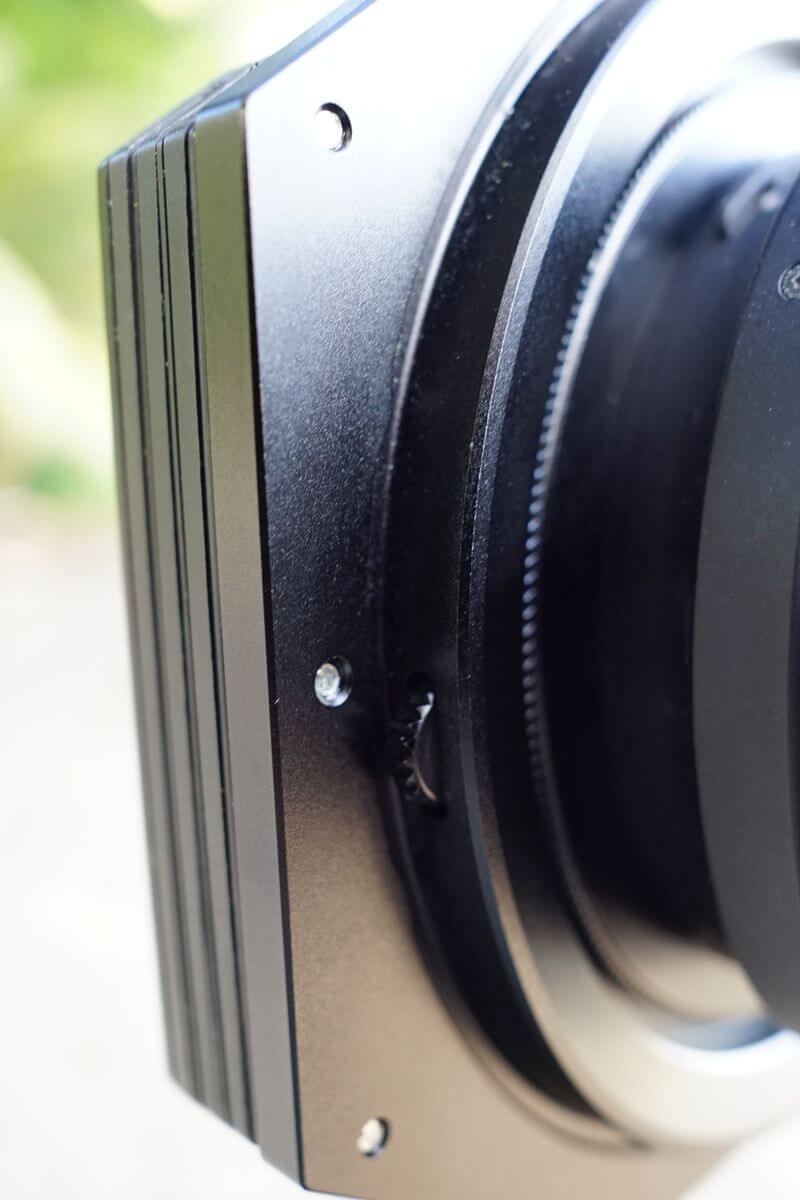



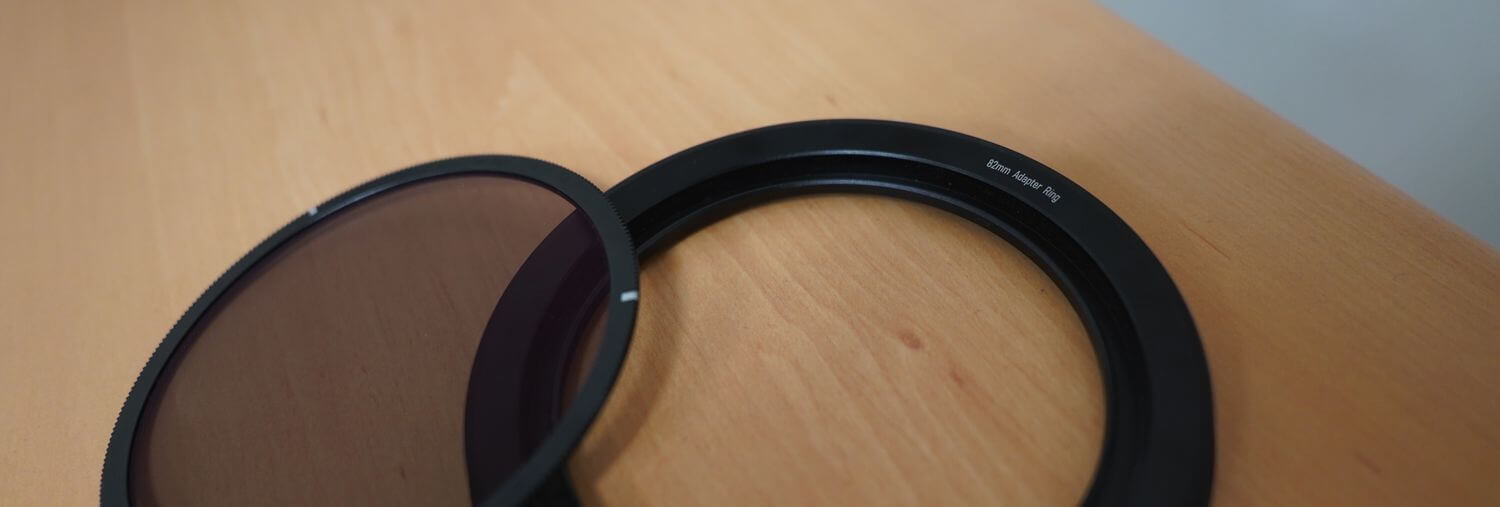
The 82mm adaptor ring was directly assembled on the filter holder when I received the kit. The 82mm adaptor ring will be used for the whole since it enables use of the CPL polarizing filter, supplied in the package. The ring is threaded on the back, allowing other smaller adaptor rings to be fitted (I’ll talk about this below, in the “installation ” section). On top of the 82mm ring, 3 arrows indicate where the magnetic CPL polarizing filter should be placed. On the side, there are two small knobs to rotate the front part of the ring on which the CPL filter is placed. This is how you can vary the degree of polarization you use when shooting, while being still free to use other ND or GND filters as you wish. The latter can be slid into the slots. I will give you my opinion on these knobs below. In any case, the ring, as well as the filter holder, look very solid.
Accessories
A few words about the accessories supplied in the package:
- The three adapter rings (step-up type) are classic ones, nothing to report on this aspect. They will allow you to use lenses with smaller diameters,
- The protective cap, supplied in the package, protects the CPL filter, once mounted on the filter holder system. It is only compatible with this 82mm ring. The yellow and grey cap looks very sturdy, especially the central part which will be used to protect the CPL. The only thing you need to know is that you have to remove the 82mm ring from the filter holder in order to put this protective cap,
- Finally, the CPL True Color polarizing filter seems to be of very good quality at first sight. It is very slim and fits perfectly on the 82mm ring supplied. Just one thing though, I would have preferred the inscriptions on the CPL “Unlock – Lock” to be written in white rather than in black. It took me a while to understand how to set the CPL on the ring according to the white arrows. More details on that in the assembly part just below.

Assembly and use in the field
As I write this article, It’s been a few weeks that I received the new V7 system from NISI. I had the opportunity to test it under different circumstances. Here are explanations on how to assemble it and my opinion on both assembly and use.
Filter holder systems are quite simple, even if they vary according to the model:
1 – To get started, you have two ways of doing it, but in any case, the first piece to set is going to be the adapter ring for the lens. Basically, the 82mm adapter ring is mounted on the filter holder and will stay there. You just need to know your lens diameter compared to the ring diameter. For example, I chose to use my Tamron 20mm f/2.8 for this review. It has a 67mm diameter. I can either decide to screw the 67-82mm step-up ring onto the front of my lens or consider screwing the 67mm step-up ring onto the back of the 82mm adapter ring (which is less convenient in my opinion).

The benefit of having 67, 72 and 77mm rings, as you can see, is that I can use this filter holder system on any lens with one of these diameters. Should I have a lens with a 55mm diameter, I would only have to buy a 55-82mm ring, which would cost me less than 10€, rather than having to buy a whole new special filter for it. If you want to know a little bit more about adapter rings, I actually wrote a full article on that.
2 – Once the adapter ring is set on my Tamron 20mm lens, I just need to screw the 82mm ring on it. As a matter of course, if you have a lens with an 82mm diameter, you don’t need to use an adapter ring and you can screw this one directly on it. Finally, you can now mount the filter holder. To do this, you will need to use the two knobs on the side, making sure you unscrew the locking screw and pull the large knob to fit the filter holder onto the 82mm ring. It’s as easy as pie!
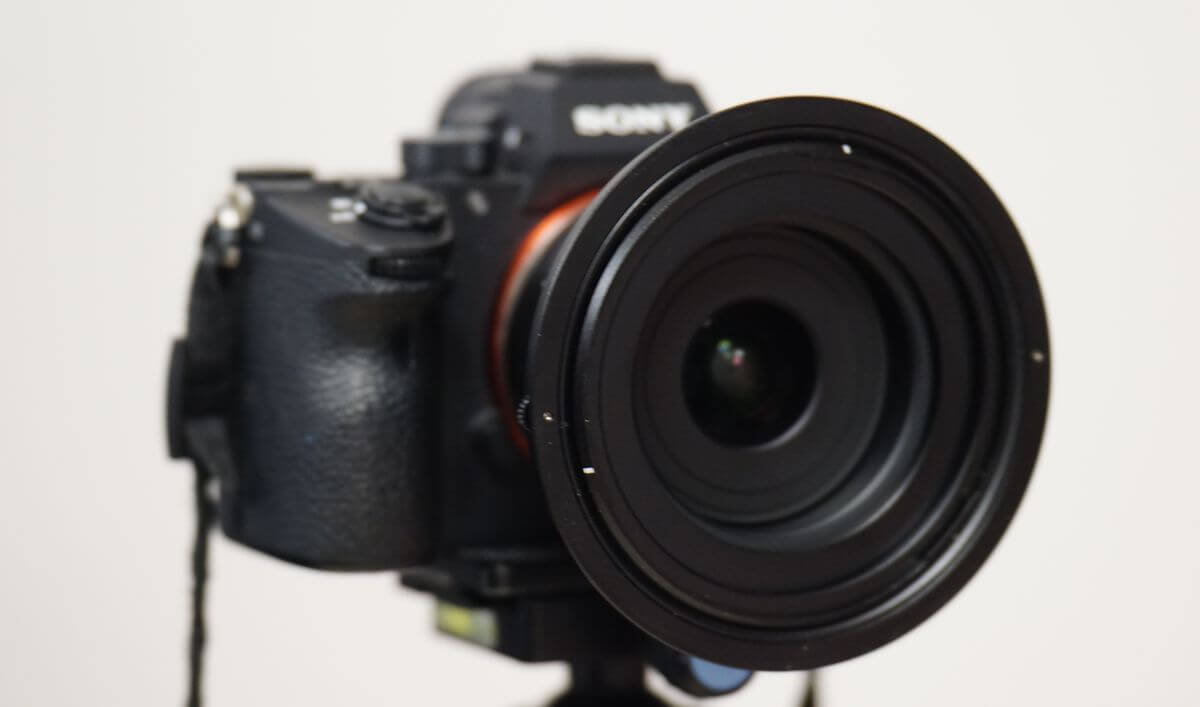

That’s it, you just need to tighten the locking screw to make sure that the filter holder is securely mounted. By the way, a little tip: if you want to unscrew the whole thing together, you can unscrew it all at once by holding the adapter ring (in my case the 67mm). This will avoid having to unscrew the 82mm ring and then the adapter ring.
3 – It is now time to mount the circular polarizing filter (CPL). I must admit that I did not read the instructions because I wanted to see if I understood the system first. To begin with, I didn’t find the idea that simple. Of course, there are 3 arrows on the 82mm ring, and the same 3 on the CPL filter. It was easy to understand that the CPL had to be placed with the three arrows facing each other. However, I did not see the lock-unlock inscription printed on the CPL which says that it must be turned to the right to lock it.

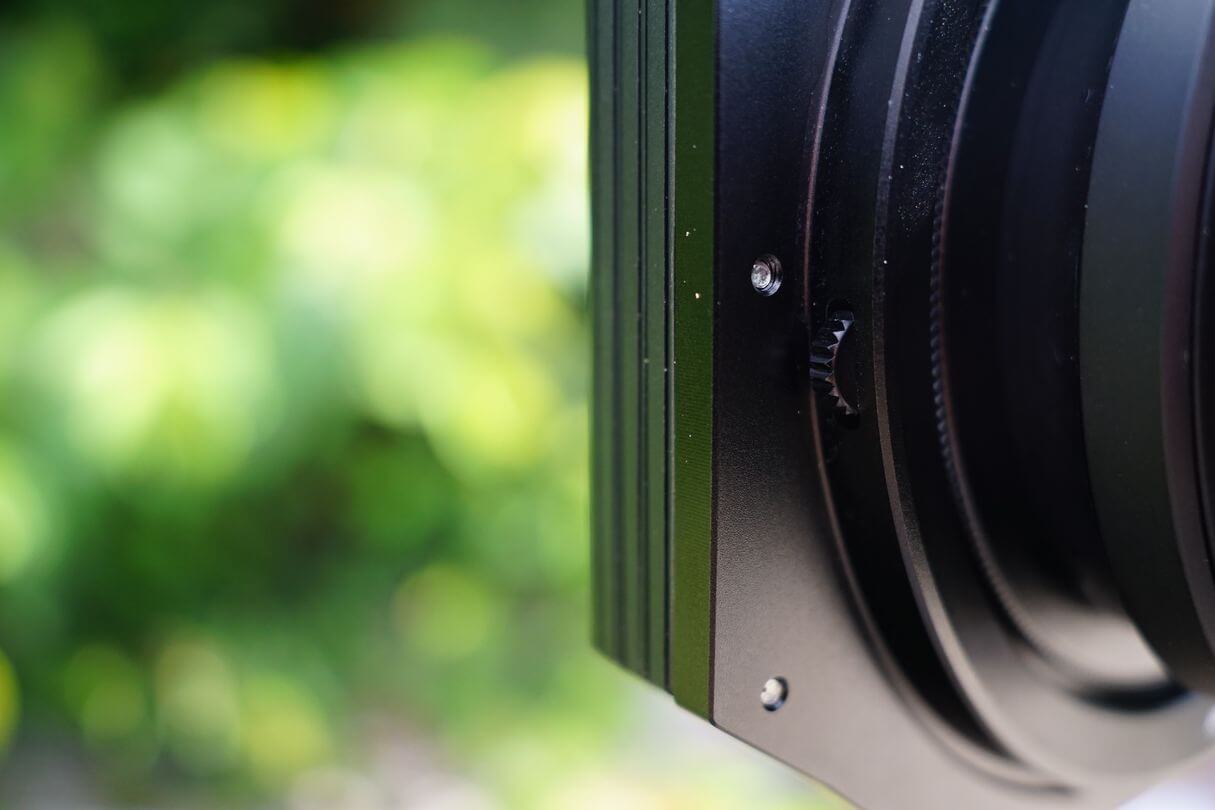
The idea is good, but the writing should have been more visible. Indeed, you may understand that you have to rotate the CPL to the right to block it but when trying to unblock it, the whole thing may start rotating and you may not be able to unlock the filter. To make it easier, I understood afterwards that you only had to lock one of the two knobs located at the back of the 82mm ring to unscrew the CPL without any problem. It’s a small detail, but I would have liked a small indentation in the 82mm ring to be able to remove the CPL more easily.
I must say that I was moderately satisfied with its use, not because of the quality of the filter but rather the system itself. I repeated the manipulation a dozen times and more, and each time, I managed to find a way to get the CPL to fall off, which does not seem stick so well. This is even truer when you use a square filter like GND or ND in front of it. If you rotate the CPL with the knob, at some point, you’ll feel the filter coming loose, and if you look closer, you’ll see the CPL actually coming off and now floating between the lens and the GND. For me, this system can be improved upon.
4 – The last step is actually the easiest since you have now reached the end and are ready to place square and/or rectangular filters into the filter holder slots. For our information, they clarify the fact that you can mount up to 3 filters on top of the polarizing filter, and that no vignetting will be visible with a full frame 16mm lens.
The only comment I have to make is about the two knobs on the back of the 82mm ring that are used to adjust the scene’s polarization. I find them a bit too small and, personally (but this is probably a matter of taste), I prefer to have a larger knob located on the side of the filter holder.

You may think that this is a long and fastidious process but the installation is actually quick and painless. As mentioned above, the filters fit perfectly and have a good hold into the slots. For me, it was a success.
V6 vs. V7
Even though I never got a hold of a V6 filter holder, I thought it might be interesting to note the main differences between the NISI V6 and V7 packages. From what I could see, here are the main differences:
- New True Color CPL which has a totally neutral color rendering,
- The filter holder locking system is new (there are 2 separate wheels on the V6),
- The CPL filter installation system on the 82mm ring has been redesigned.
CPL True Color polarizing filter test
Coming to the end of this review, I had to do some tests to see what it was capable of. I have to say that I was very pleasantly surprised. The CPL brings out contrast and colors perfectly while saturating them. This is even more obvious when looking at the sky.
Below are a few photos shot with and without the polarizing filter.


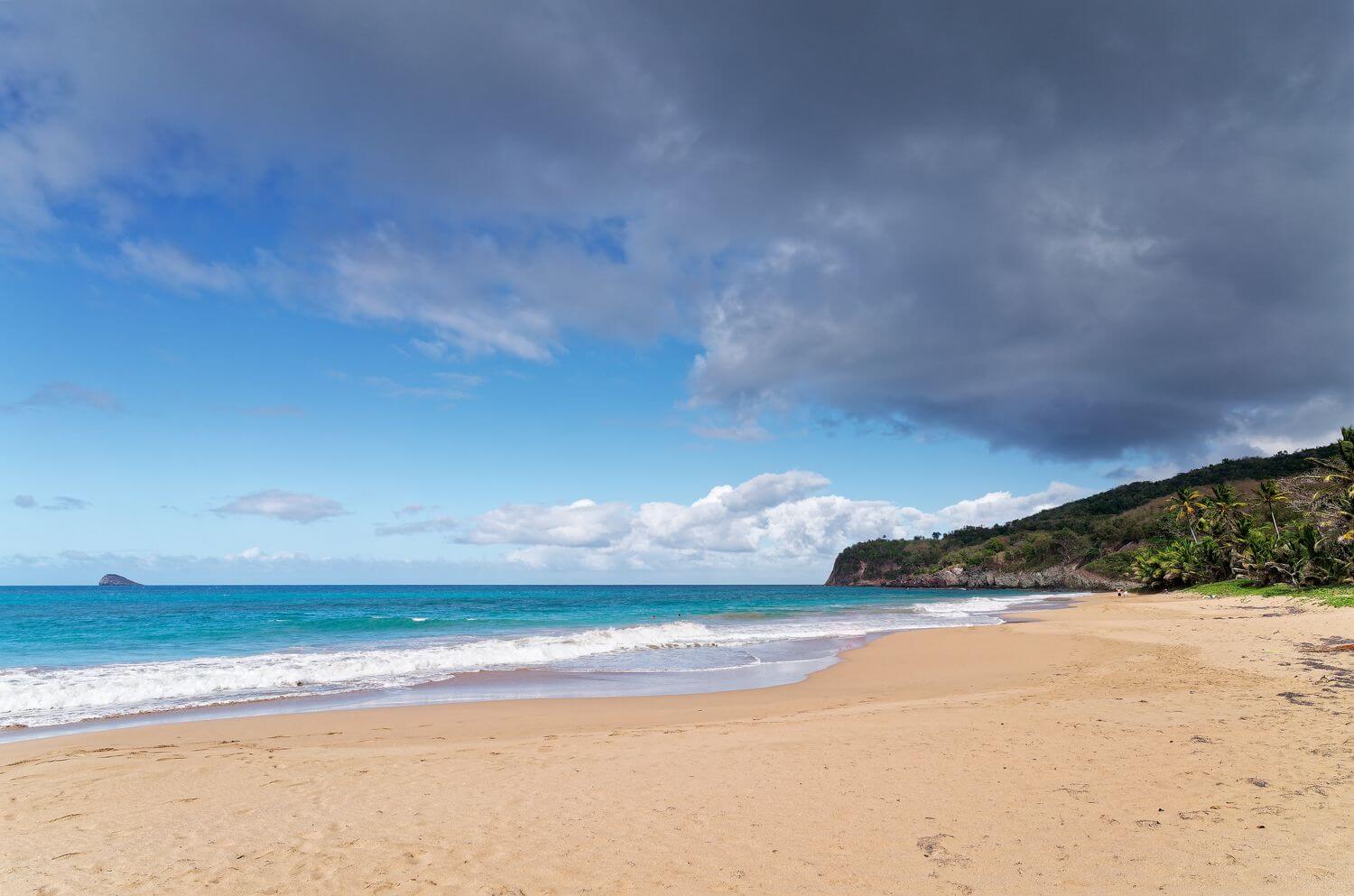

We also performed sharpness tests with and without the filter to see if it did not deteriorate image quality. Nothing to complain about, it’s perfect! We didn’t detect any image quality loss with the filter on, which says a lot about the very good quality of this filter.
Here I am, at the end of this new NISI V7 filter holder review. I was really seduced by its quality and sturdiness. Clearly, it will last, in my opinion. The system is pretty well thought out, although there are a few things that bothered me personally, including the small knobs that I would have preferred elsewhere, and the logic behind locking/unlocking the CPL which doesn’t seem intuitive at first. Also, the fact that the CPL doesn’t stay perfectly attach depending on how you use it, is something to be improved. However, once you get the hang of it, it’s not a problem anymore.
In the context of this review, I was not able to review NISI’s GND and ND filters, but the quality of the new V7 filter holder is clearly there. Compared to the one I’m currently using, it really is a no-brainer, and my old one will now remain stored in my bag!
We will continue to review more camera gear, and we can already tell you that we are about to set up our first official partnership with a lens company to review their gear! We’re looking forward to it and we’ll let you know soon!
See you soon,

Written by Sylvain PONS
I've been passionate about photography since 2010, learning as I went along. Today, I dedicate myself to guiding others in their choice of camera gear and sharing a variety of tips to improve their photography skills.
Despite our care, a mistake may have slipped into this article. If you find any, please don't hesitate to let us know so we can correct it as soon as possible and keep our information up-to-date!






